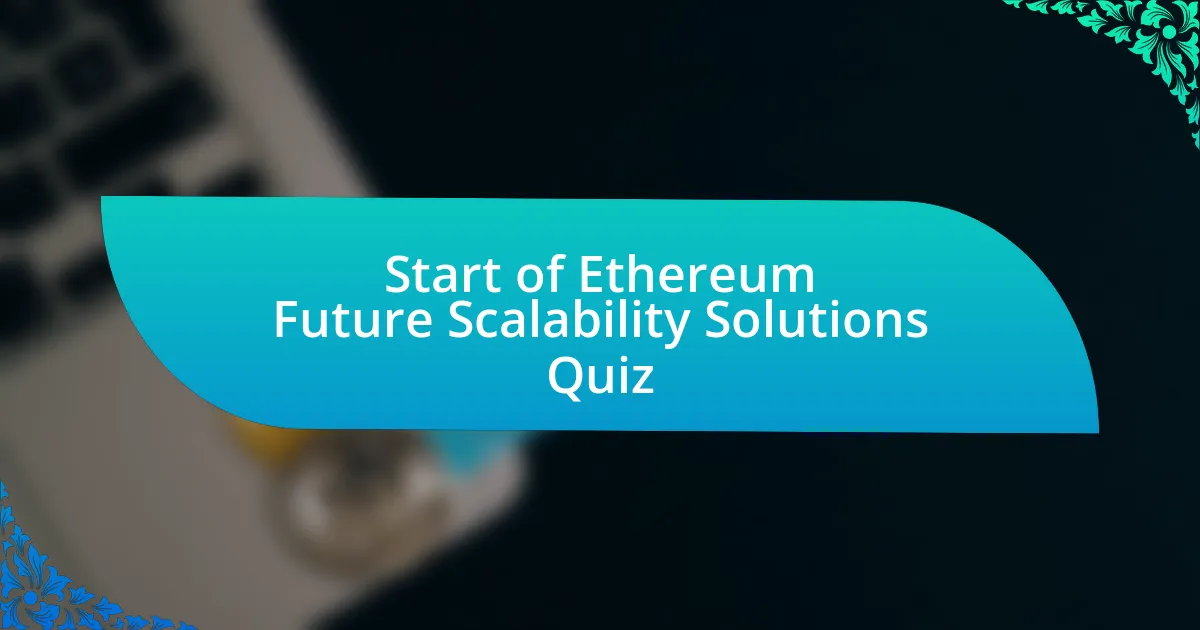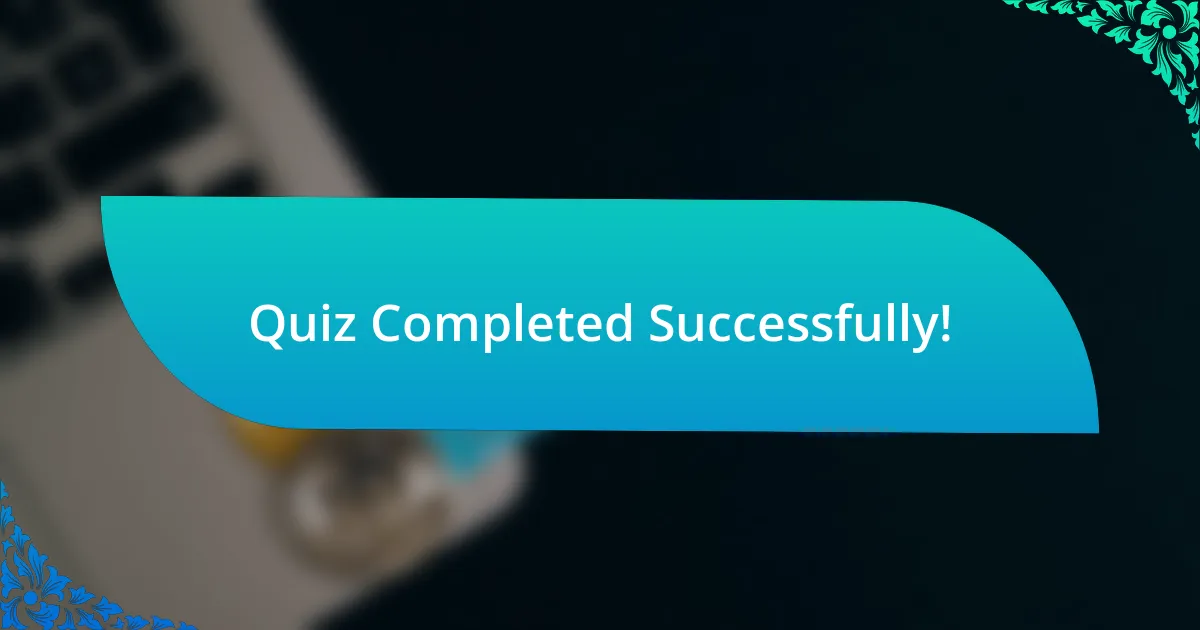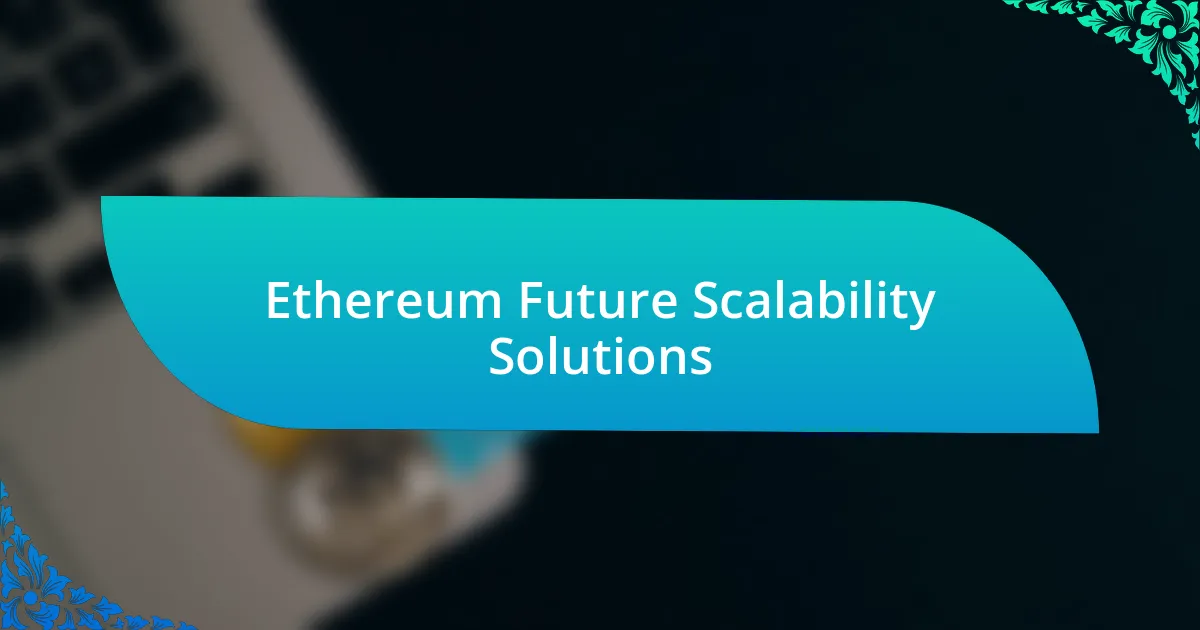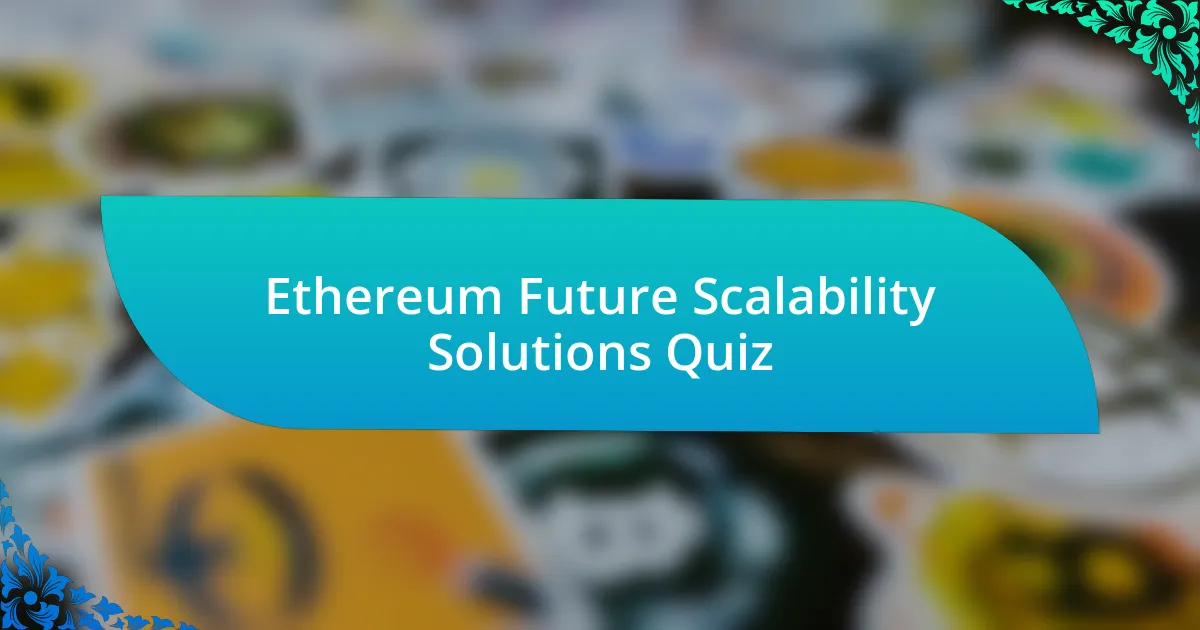
Start of Ethereum Future Scalability Solutions Quiz
1. What is the primary goal of Ethereum`s Layer 2 scaling solutions?
- To create new cryptocurrencies for trading.
- To limit transaction speeds to a specific threshold.
- To centralize control over the blockchain network.
- To enhance scalability, reduce costs, and improve user experience.
2. What are some key technologies used in Ethereum`s Layer 2 solutions?
- Forks, mining pools, and hash rates.
- Sidechains, mainnets, and private keys.
- Validators, block rewards, and consensus algorithms.
- Rollups, state channels, and other Layer 2 technologies.
3. How do state channels improve Ethereum`s scalability?
- By enabling certain blockchain participants to transact off-chain, reducing the number of on-chain transactions.
- By lowering the total number of validators needed for network confirmation.
- By requiring all transactions to be processed solely on-chain for added security.
- By increasing the number of miners directly involved in transactions.
4. What is the concept of sharding in Ethereum?
- Merging all transactions into a single block for processing.
- Dividing the Ethereum blockchain into multiple horizontal partitions called shards, each processing a subset of transactions simultaneously.
- Increasing the block size to accommodate more transactions at once.
- Creating a single transaction ledger that everyone must access.
5. Why is sharding necessary for Ethereum?
- To enhance the aesthetic design of the Ethereum platform.
- To simplify the programming languages used for smart contracts.
- To increase transaction processing capacity without compromising security.
- To reduce the size of the Ethereum blockchain permanently.
6. What is the current consensus mechanism used by Ethereum?
- Proof-of-Work (PoW)
- Delegated Proof-of-Stake (DPoS)
- Proof-of-Stake (PoS)
- Practical Byzantine Fault Tolerance (PBFT)
7. What is Ethereum 2.0 (Eth2)?
- A new cryptocurrency created to replace Bitcoin.
- A multifaceted upgrade designed to address scalability challenges and enhance efficiency.
- A minor software update with no significant impact on Ethereum.
- A marketing campaign to promote Ethereum’s existing features.
8. What is the role of validators in the Ethereum network?
- To create new cryptocurrencies based on Ethereum`s protocol.
- To mine Bitcoin by linking it to Ethereum`s blockchain.
- To enforce regulations on transactions made within the network.
- To validate information in blocks and propose new ones, receiving ether tokens for their work.
9. How does the Ethereum blockchain work?
- It relies on a single individual to validate and store all blockchain information.
- It uses a distributed ledger where each block contains encoded data from the previous block and new information.
- It employs a central server to manage all transactions and records.
- It operates using a traditional database system to store transaction data.
10. What is the difference between Ethereum and Bitcoin in terms of transaction processing fees?
- Bitcoin`s fees are always higher and fixed, while Ethereum`s are variable.
- Ethereum has no transaction fees, while Bitcoin has low fees paid to users.
- Ethereum`s gas fees are paid by participants and burned by the network, while Bitcoin`s fees are paid to miners.
- Bitcoin`s fees are paid to the network, while Ethereum`s are only for large transactions.
11. What is danksharding?
- A system for creating digital art using blockchain technology.
- An algorithm used to mine Ethereum efficiently.
- A method where transactions are processed off-chain, rolled up, and posted to the main chain via BLOBs.
- A new type of cryptocurrency built on the Ethereum network.
12. How does danksharding reduce costs and increase transaction processing speeds?
- By increasing block size limits and allowing more transactions in each block.
- By requiring fewer confirmations for each transaction to be considered valid.
- By processing transactions off-chain and then summarizing them using data availability sampling before posting to the main chain.
- By implementing a new consensus algorithm that speeds up block creation.
13. What is the purpose of the sharding manager contract in Ethereum?
- To create new cryptocurrencies within the network.
- To review and merge shard block votes from notaries into the main Ethereum chain.
- To randomly assign tasks to network participants for verification.
- To store user data securely for transactions.
14. What are collations in the context of Ethereum sharding?
- Independent packets of data processed individually.
- Temporary storage of unprocessed data before validation.
- Shard blocks that are chained together like regular blockchain blocks.
- Standalone transactions that do not interact with each other.
15. How do notaries participate in Ethereum sharding?
- Notaries manage user transactions directly on the blockchain.
- Notaries create new shards by splitting existing ones.
- Notaries periodically vote on the validity of blocks within their shard.
- Notaries are responsible for designing Ethereum upgrade proposals.
16. What is the significance of sharding in solving the scalability trilemma?
- It prioritizes security over scalability in blockchain networks.
- It allows for decentralized, scalable, and secure blockchain operations without sacrificing one of these traits.
- It centralizes transaction processing for better efficiency and speed.
- It eliminates the need for gas fees entirely in transaction processing.
17. What is the difference between sharding and danksharding?
- Sharding focuses solely on security, while danksharding exclusively enhances user experience.
- Sharding involves dividing the blockchain into shards, while danksharding involves processing transactions off-chain and then posting them to the main chain via BLOBs.
- Sharding requires on-chain processing, while danksharding does not.
- Sharding is about increasing fees, while danksharding decreases congestion.
18. How does Ethereum`s current linear transaction processing approach limit its scalability?
- It automatically reduces transaction fees by splitting transactions into smaller parts.
- It processes transactions at an extremely high speed, ensuring low fees and no congestion.
- It can only handle a limited number of transactions per second (TPS), leading to congestion and high gas fees.
- It allows for unlimited transactions simultaneously, making it very efficient.
19. What is the expected impact of danksharding on Ethereum`s transaction processing speeds?
- It is expected to decrease transaction processing speeds significantly.
- It is expected to have no impact on transaction processing speeds.
- It is expected to cause frequent transaction failures.
- It is expected to greatly increase transaction processing speeds when combined with other technologies.
20. What is the role of data availability sampling in danksharding?
- It directly verifies the authenticity of on-chain transactions.
- It helps summarize transactions processed off-chain before posting them to the main chain.
- It increases the size of the blockchain by adding more data.
- It eliminates the need for validators in the network.
21. How does the Ethereum community plan to achieve full scalability?
- By combining Layer 2 solutions with ongoing improvements to the Ethereum Mainnet.
- By switching the entire network to a centralized server model.
- By exclusively relying on Proof-of-Work mining methods.
- By eliminating all blockchain transactions completely.
22. What is the importance of collaboration and innovation in the adoption of Layer 2 solutions?
- It complicates the integration of decentralized applications.
- It ensures the long-term success and adoption of these solutions.
- It reduces the overall security of the blockchain.
- It limits the number of transactions that can be processed.
23. What is the significance of Ethereum`s sharding roadmap in its future development?
- It outlines a phased approach to implementing sharding, which is crucial for enhancing Ethereum’s transaction processing capabilities.
- It provides a framework for merging Ethereum with other cryptocurrencies.
- It focuses on reducing the block size for faster transaction confirmation.
- It introduces smart contracts for better governance of the network.
24. How does sharding address the scalability challenge of Ethereum 1.0?
- By transferring all transactions to a secondary chain and freezing the main chain.
- By requiring every transaction to be validated by all network participants.
- By allowing all transactions to be processed in a single line for better tracking.
- By introducing parallel processing of transactions across multiple shards, significantly increasing the network’s overall throughput.
25. What is the relationship between Ethereum and its native cryptocurrency?
- Ethereum is a payment service, and its cryptocurrency is called cash.
- Ethereum is a decentralized platform powered by blockchain technology, and its native cryptocurrency is ether (ETH).
- Ethereum is a social network with its cryptocurrency called e-coin.
- Ethereum is a game platform where its cryptocurrency is known as tokens.
26. How do gas fees work on the Ethereum network?
- Gas fees are determined by the Ethereum miners and redistributed to users.
- Gas fees are fixed amounts that do not change regardless of network activity.
- Gas fees are paid by participants in Ethereum transactions and burned by the network.
- Gas fees are only required for users sending large amounts of ether.
27. What is the maximum number of bitcoins that can enter circulation?
- 30 million
- 25 million
- 15 million
- 21 million
28. What is the current number of Ethereum coins in circulation?
- Around 100 million as of September 2022.
- Approximately 80 million as of January 2023.
- Nearly 150 million as of March 2025.
- Just over 120 million as of May 2024.
29. What is the primary distinction between Ethereum and Bitcoin?
- Ethereum is capped at 21 million coins, similar to Bitcoin.
- Ethereum supports decentralized applications, while Bitcoin focuses on payments.
- Bitcoin has a smart contract functionality like Ethereum.
- Bitcoin uses sharding to improve its transaction speeds.
30. How does Ethereum`s blockchain architecture ensure data integrity?
- Each block is stored in a separate database managed by individual users.
- Data integrity is maintained solely through transaction fees paid by users.
- Each block is linked to the next using a central server for validation.
- Each block contains encoded data from the previous block, creating an immutable chain of information.

Quiz Completed Successfully!
Congratulations on completing the quiz on Ethereum Future Scalability Solutions! This journey through critical concepts has offered you valuable insights into the evolving landscape of Ethereum. You’ve learned about the challenges surrounding scalability and explored various proposed solutions, such as Layer 2 scaling, sharding, and improvements to the Ethereum protocol itself. Each question was designed to deepen your understanding and enhance your familiarity with key terms and ideas.
As you reflect on your learning experience, consider how these scalability solutions can impact the broader blockchain ecosystem. Understanding these advancements can enable you to engage more effectively in discussions about cryptocurrency and its potential to reshape industries. The knowledge you’ve gained not only enriches your personal expertise but also prepares you for future developments in this fast-paced field.
We invite you to delve further into the topic of Ethereum Future Scalability Solutions. Head over to the next section on this page for an in-depth exploration. Here, you’ll find additional resources that can expand your understanding and keep you up to date with the latest advancements. Continue your journey and stay informed!

Ethereum Future Scalability Solutions
Overview of Ethereum Scalability Issues
Ethereum faces significant scalability challenges, primarily due to its original proof-of-work consensus mechanism and the growing number of decentralized applications (dApps). The current network can process around 30 transactions per second (TPS), limited by block size and time. As more users interact with the Ethereum network, congestion leads to slower transactions and higher gas fees, hindering usability and efficiency.
Layer 2 Solutions for Ethereum Scalability
Layer 2 solutions aim to enhance Ethereum’s scalability without altering the main blockchain. These solutions, such as Rollups, utilize secondary layers that bundle transactions before submitting them to the main chain. This process allows significantly higher TPS and lowers transaction costs. Rollups, including Optimistic and ZK-Rollups, are designed to maintain Ethereum’s security while increasing throughput, thus addressing the current limitations of the base layer.
Sharding as a Future Ethereum Solution
Sharding is a proposed scalability solution that involves partitioning the Ethereum blockchain into smaller, more manageable pieces, called shards. Each shard processes its transactions and smart contracts independently, parallelizing workload and increasing total network capacity. This approach is intended to allow Ethereum to handle thousands of TPS once fully implemented, dramatically improving overall performance and reducing congestion during peak usage.
Ethereum 2.0 Transition and Its Impact on Scalability
The transition to Ethereum 2.0 involves moving from a proof-of-work to a proof-of-stake consensus mechanism. This upgrade is expected to boost scalability by reducing the energy consumption associated with mining and enabling features like sharding. As Ethereum evolves, these improvements will help accommodate a larger user base and more complex smart contracts, paving the way for a more sustainable and efficient network.
The Role of Alternative Consensus Mechanisms in Enhancing Scalability
Alternative consensus mechanisms, such as proof-of-stake (PoS) and delegated proof-of-stake (DPoS), play a crucial role in enhancing Ethereum’s scalability. PoS allows validators to stake their tokens rather than solve computational puzzles, speeding up transaction processing. Additionally, DPoS enables token holders to vote for delegates to validate transactions on their behalf, further increasing network efficiency and scalability while preserving decentralization.
What are Ethereum’s future scalability solutions?
Ethereum’s future scalability solutions include sharding, layer 2 solutions like rollups, and the Ethereum 2.0 upgrade. Sharding will split the Ethereum blockchain into partitions, enabling parallel processing of transactions. Layer 2 solutions, such as Optimistic and Zero-Knowledge Rollups, process transactions off-chain and then commit them to the Ethereum mainnet, reducing congestion. The Ethereum 2.0 upgrade transitions the network from Proof of Work to Proof of Stake, improving transaction speed and energy efficiency.
How do layer 2 solutions improve Ethereum scalability?
Layer 2 solutions improve Ethereum scalability by offloading transaction processing from the main blockchain. This reduces the load on the Ethereum network, enabling faster transactions and lower fees. For example, Optimistic Rollups assume transactions are valid and only check them if a challenge occurs, while Zero-Knowledge Rollups bundle transactions and provide a cryptographic proof of validity. This significantly enhances throughput compared to processing all transactions on-chain.
Where can developers implement sharding in Ethereum?
Developers can implement sharding in Ethereum primarily during the Ethereum 2.0 rollout. Sharding is planned to be introduced in a future phase after the transition to Proof of Stake has been completed. The implementation will involve creating multiple shards that each handle a portion of the network’s transactions. This decentralized method aims to enhance overall network capacity and efficiency.
When is Ethereum expected to fully transition to scalable solutions?
Ethereum is expected to fully transition to scalable solutions with the complete rollout of Ethereum 2.0, projected to occur in phases over the next few years. The final phase, which includes the full implementation of sharding, is anticipated to be completed by late 2023 or beyond. This timeline focuses on enhancing the network’s scalability while maintaining security and decentralization.
Who is responsible for developing Ethereum’s scalability solutions?
The Ethereum Foundation and various developers in the Ethereum community are responsible for developing scalability solutions. This includes contributions from independent teams, researchers, and projects within the Ethereum ecosystem. Collaborative efforts focus on enhancing the protocol to meet growing demand while addressing scalability challenges effectively.

